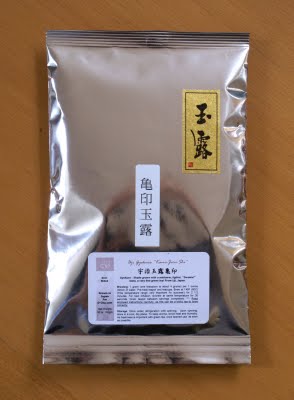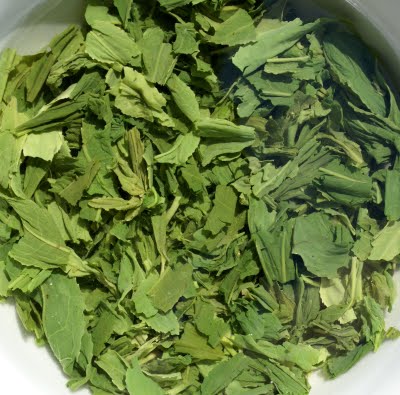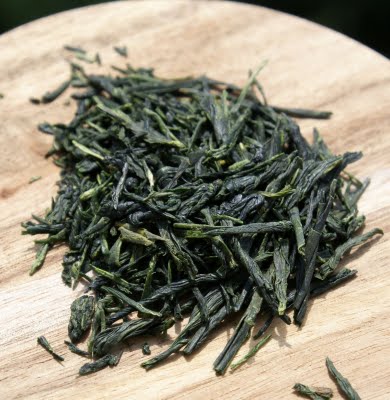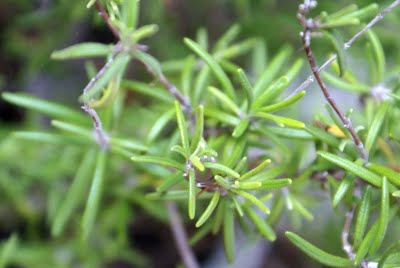(9) 2008 Kame-Jiru-Shi Gyokuro
Posted on 10 August 2009
Other posts in this series:
2008 Gyokuro Tama Homare (Marukyu)
2008 Kabusecha Takamado (Marukyu)
2008 Karigane Otowa (Marukyu)
2008 Sencha Miyabi (O-Cha)
2009 Shincha Fukamushi Supreme (O-Cha)
2009 Shincha Shigaraki (Marukyu)
2009 Shincha Shuei (Marukyu)
2009 Shincha Uji Gold (Marukyu)
2009 Shincha Yutakamidori (O-Cha)

No need for fancy packaging here.
Oh, gyokuro! Is there any other tea that triggers the same sense of excitement and festivity? I guess not. You can have an inexpensive Longjing or a rock-bottom Oriental Beauty but there’s no such thing as unprestigious gyokuro. From the curiosities of its production technology (ah, that congenial move to shade the tea plants!) to the oddities of its brewing parameters (I like someone’s metaphor about the water temperature: it should be like a bath, not hotter), everything about gyokuro is special.
You’ll find lots of technical information about gyokuro on the web, including graphs of how the catechin content stays low while the theanine alongside chlorophyll soar. I prefer to think of gyokuro poetically as the very essence of the tea plant. There is something virginal about it. It comes closest, perhaps, to a great Italian extra virgin olive oil in all its opaque density and unabashed intensity. A freshly pressed olive oil from Spoleto or Bibbona is more than biting into a fresh olive: it is a distillate of the olive’s characteristics. Likewise with gyokuro.
It is ironic that being the least bitter of all green teas (courtesy of shade-growing), therefore the least susceptible to overbrewing, it is brewed at record-low temperatures. As a tea drinker, you’re supposed to show respect, even reverence towards these special leaves. Whether you steep at 45C or 65C is a matter of personal preference, though, or fine-tuning your technique to a particular tea. Same about dosage: 3g / 100ml of water is considered standard but I know of people going up to 6g.
This 2008 Gyokuro Kame-Jiru-Shi is from O-Cha and at $56 / 100g, one of their more expensive gyokuro offerings. (Now available in the 2009 vintage). From Uji, a prestige appellation for any Japanese tea (most gyokuro is produced in Yame). It shows a good leaf, however a little larger than expected for an early spring flush gyokuro; visually, with its oblong rolled leaf, it resembles a Chinese Guapian perhaps. A very nice leaf aroma: clean and linear vegetality (spinach, olive oil, artichoke?); pleasant baked bread low roast when warmed.

Tiny as they are, these leaves have a lot of power.
The vendor-recommended parameters are 3.3g of leaf / 100ml and 60C. To be honest, I’ve not had luck with these. The tea comes out clean and fresh but a little pale and unconcentrated. There’s a clear umami character throughout the session, yet balanced by an intensely leafy, vegetal character. From the second brewing onwards, there emerges an odd, not very pleasant powdery matcha-like character (sign of this 2008 going stale? But tasting notes were taken on the day I opened the pack).
Perhaps I underdosed the tea, I thought, so for my next attempt I climbed to 5g and 3 minutes at 55C. A lot better, with more texture and that tell-tale gyokuro combination of glutamic umami character and sweetness (almost like raspberries – amazing). But the second brewing reverts to that powderiness I dislike.
This tea appears to have a narrow brewing window: to get it right, you need to be generous with the leaf and patient with the infusion time (but then you’ll only get one good infusion). Otherwise the tea will taste underbrewed, and some not-too-pleasant side notes emerge (apart from the matcha dustiness, I also got a sardine fishiness), making it rather underwhelming for the price. The quality of the leaf is good, but the leaves seem a bit large and some are considerably lighter in colour (see photo); well, it’s a 2008 that you’d be expected to drink up very soon. I will.



